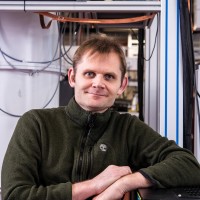
Prof. S.-R. Eric Yang,
Korea University, Dept. of Physics, 02855, Seoul, South Korea
Topologically ordered zigzag graphene nanoribbon
When: 12:00-13:00 CET, June 1st (Thursday), 2023
Where: Seminar Room, ICMM-CSIC, Campus de Cantoblanco, Madrid
Interacting disordered graphene zigzag ribbons are a new topologically ordered Mott–Anderson insulator displaying e–/2 fractional charges, spin-charge separation, and two degenerate ground states1,2. The disorder is a singular perturbation that couples electrons on opposing zigzag edges, resulting in instantons. This effect converts zigzag ribbons from a symmetry protected phase to a topologically ordered phase and generates e–/2 fractional charges on the opposite zigzag edges. These fractional charges are protected by an exponentially decaying soft gap. Furthermore, an interacting disordered zigzag nanoribbon has a finite topological entanglement entropy and its entanglement spectrum resembles the corresponding edge spectrum of the system. Doped ribbons display the following effects3, which can be experimentally tested: (1) In the low doping case and weak disorder regime, the soft gap in the tunneling density of states of the undoped case is replaced by a sharp peak at the midgap energy with two accompanying peaks. The e–/2 fractional charges that reside on the boundary of the zigzag edges are responsible for the midgap peak. Localization effects play an important role in the quantization of these fractional charges. (2) The midgap peak disappears as the doping concentration increases. The presence of e–/2 fractional charges will be strongly supported by the detection of these peaks. Doped zigzag ribbons may also exhibit unusual transport, magnetic, and inter-edge tunneling properties.
1. S.-R. Eric Yang, Topologically Ordered Zigzag Nanoribbon: e/2 Fractionally Charged Anyons and Spin-Charge Separation. (World Scientific, Singapore 2023).
2. S.-R. Eric Yang, Min-Chul Cha, Hye Jeong Lee, and Young Heon Kim, Phys. Rev. Research 2, 033109 (2020).
3. Young Heon Kim, Hye Jeong Lee, Hyun-Yong Lee, and S.-R. Eric Yang, Sci. Rep. 12, 14551 (2022).
